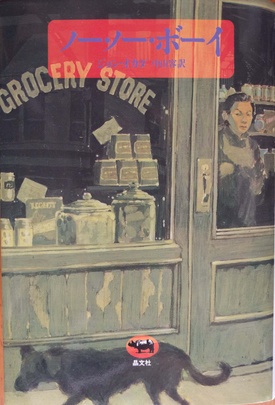Translated by Yo Nakayama in 1979
The novel "No-No Boy" was republished in the United States in 1976. Three years later, in March 1979, a Japanese translation was published. The publisher was Shobunsha (Chiyoda-ku, Tokyo), a company that handles unique works such as translations of foreign literary works, and the translation was done by Nakayama Yo.
The title of the translation is written as "No No Boy" and is accompanied by the introduction, "The year is 1945, and Ichiro has returned to his hometown of Seattle after serving two years in prison for refusing to be drafted. This is a masterpiece coming-of-age novel by a second-generation Japanese-American, portraying with thumping rhythm the image of a wandering soul, deeply troubled and wounded in search of its own way in life."
The profile of the translator, Mr. Nakayama (at the time) was as follows:
Born in Tokyo in 1931. Graduated from Meiji Gakuin University, Department of English Literature, and International Christian University, Master's Program in Audiovisual Education. Currently a professor at Kyoto Heian Jogakuin Junior College. Translated works include "Complete Poems of Bob Dylan" (Shobunsha, co-translation), "Poems of William Carlos Williams" (Kokubunsha, co-translation), and "Poems of Lawrence Ferlinghetti" (Shichosha, co-translation). He also translates folk song lyrics.
Nakayama introduced American folk songs and influenced the Kansai folk music scene, and was also active in cultural activities such as translating Beat poets and reciting their poems in addition to his own poetry. He was also involved in the research and introduction of Asian American literature.
He translated Studs Terkel's "The Good War" (Shobunsha), who later won the Pulitzer Prize, and published "Bob Dylan Complete Poems 302" (Shobunsha), co-translating it with Yuzuru Katagiri. He also served as dean of Kyoto Seika University, where he passed away in 1997.
"Discovered" in Honyara Cave, Kyoto
At the end of the Japanese edition, Nakayama writes in the "Translator's Notes" about his encounter with the reprinted English version as follows:
I saw this reprint of No-No Boy on the second floor of Kyoto's Honyarado, and at the time I thought it belonged to Midori, a third-generation Japanese-American who worked there. In fact, it seems that Nakao Hajime brought it back from Seattle in 1976. But neither Hajime nor Midori had read it yet. Once I started, I couldn't stop. As I read, I realized that the characters and their lifestyles overlapped with my own childhood.
Honyara Do is a coffee shop in Demachiyanagi, Kyoto City, which was opened in 1972 with funding from folk singer Nobuyasu Okabayashi and others. Music concerts and poetry readings were held here, and Nakayama himself was a frequent visitor, giving poetry readings there as well.
Nakayama met No-No Boy in the space on the second floor where live performances were held. Hajime Nakao is a social psychologist, and Midori is the daughter of Pat Morita, who played the karate master in the hit Japanese film series The Karate Kid. Honyara Cave was run by photographer Fusayoshi Kai, who had been involved in its management since its early days, but the building was destroyed by fire in January 2015.
The Japanese version has sold a total of 9,000 copies.
The reason why it was published by Shobunsha was because Nakayama was friends with Kaitaro Tsuno (Professor Emeritus at Wako University), who was then working at Shobunsha. The cover of the Japanese version was completely different from the strong image of the first edition in 1957, and also from the abstract image of the cover of the reprint.
The painting depicts a grocery store run by a Japanese person that once stood in Seattle's Japantown, which is reminiscent of the store run by the parents of Ichiro, the protagonist in the novel.
The book was designed by Koga Hirano, who asked Toshinori Yasuku to draw the cover. The design does not represent the central theme of the novel, such as Ichiro's inner conflict, but rather brings out the exotic atmosphere of the local area that surrounds Japanese Americans.
According to Shobunsha, the first printing of the Japanese version (March 30, 1979) was 2,500 copies, and after several reprints, it went into the 8th printing in 1994, at which point the total number of copies had reached 7,500. After that, it was not reprinted for a while. In 2002, it was reprinted as a 9th printing, with 500 copies reprinted as a request reprint. However, this was the last time.
Currently, the Japanese version of "No, No Boy" can only be read in Japanese by finding it at a used bookstore or in a library.
© 2016 Ryusuke Kawai







